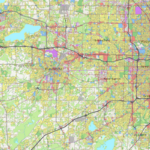Couple in their yard in front of their retirement house at Orange Lake Village, a retirement subdivision near St. Petersburg, Florida, by James Rosati & Sons (builders), from NBC/BBC television broadcast, “Report from America: Generation of Elders,” 1957. Courtesy of the National Archives, 306-RFA-16
Time and Place
Time: 4:30pm (Central)
Location: Architecture and Urban Planning Room 110 – UWM Campus – 2131 E Hartford Ave, Milwaukee, WI 53211 or by via Zoom
Sponsored by ARCHNET student organization
The Florida Retirement Village: Building for White, Middle-Class Older Adults in South Florida in the 1950s by Anna Andrzejewski
BIO:
Anna Andrzejewski is a Professor in the Department of Art History at the University of Wisconsin-Madison. She is the former Director of the Center for Culture, History, and Environment at UW-Madison and is also an affiliate of the Department of Planning and Landscape Architecture, the Department of Geography, and the Department of Architecture (University of Wisconsin-Milwaukee). She teaches courses in the history of American art, architecture, and material culture. Anna’s research centers on American architecture of the nineteenth and twentieth centuries.
Her first book, Building Power: Architecture and the Ideology of Surveillance in Victorian America, was published by the University of Tennessee Press (2008). Her current research examines post-1945 suburban communities. Anna is completing a book entitled Building Paradise: South Florida’s Vacation and Retirement Landscape. She has completed another book manuscript provisionally entitled One Builder: Marshall Erdman and the Postwar Building Industry in the U.S.
LECTURE SUMMARY:
This talk examines the “Florida retirement village,” a new type of suburban community, which emerged to house retirees in South Florida during the 1950s. It discusses the ways in which merchant builders refashioned the typical middle-class postwar suburban development model for this newly emerging market, replacing features – playgrounds, and schools – with amenities to appeal to older adults. Inspiration for the Florida retirement village came from three sources. One was the then-popular trailer park, which was attracting increasing numbers of snowbirds to relocate to Florida seasonally. Another was the fledgling field of gerontology, which was particularly active in Florida in the 1950s. A final factor lay with the state government, whose fear that Florida might attract the “wrong” kind of migrant-funded efforts in community design that would support a middle-class suburban model suited to older adults, many of whom were pensioners benefitting from Social Security or industrial pensions. The solution that arose – the Florida retirement village — paved the way for what is now understood as a distinctive component of Florida’s cultural landscape: “active retirement” communities such as “The Villages.” Examining the origins of these kinds of places in the 1950s contributes to a rapidly growing literature on 55+ housing while also helping us better understand the rise of South Florida as a destination for white, middle-class older adults after World War II.
Need Directions?
Get directions to The School of Architecture and Urban Planning building at the University of Wisconsin-Milwaukee is located at 2131 East Hartford Avenue, Milwaukee, Wisconsin.
AIA/CES LU|HSW credits will be awarded.
Questions, comments?
All lectures are free and open to the public.
Additional information about the lectures and exhibitions can be found by contacting the main reception at (414) 229-4014, and by emailing any inquiries to Kyle Reynolds.



